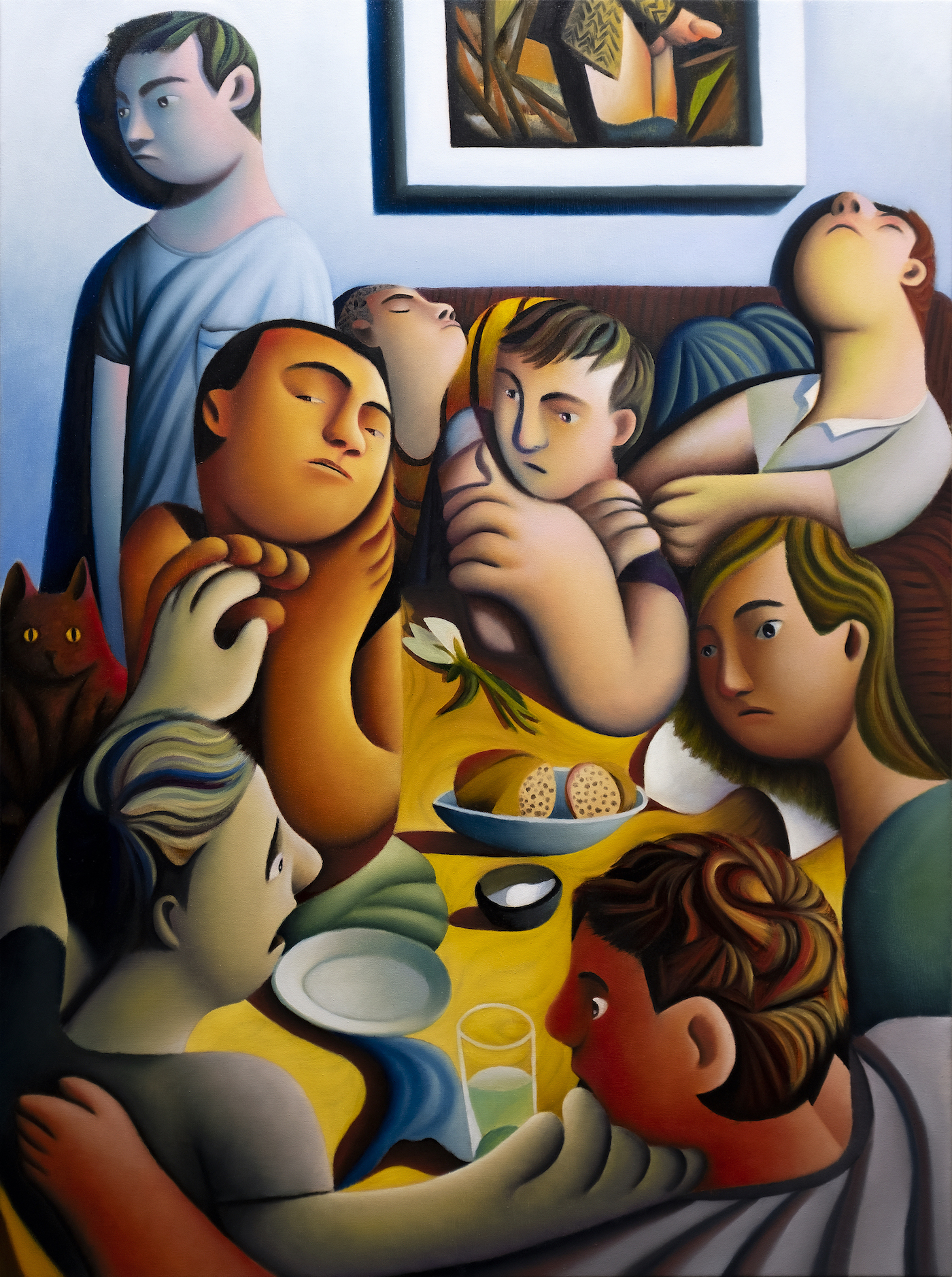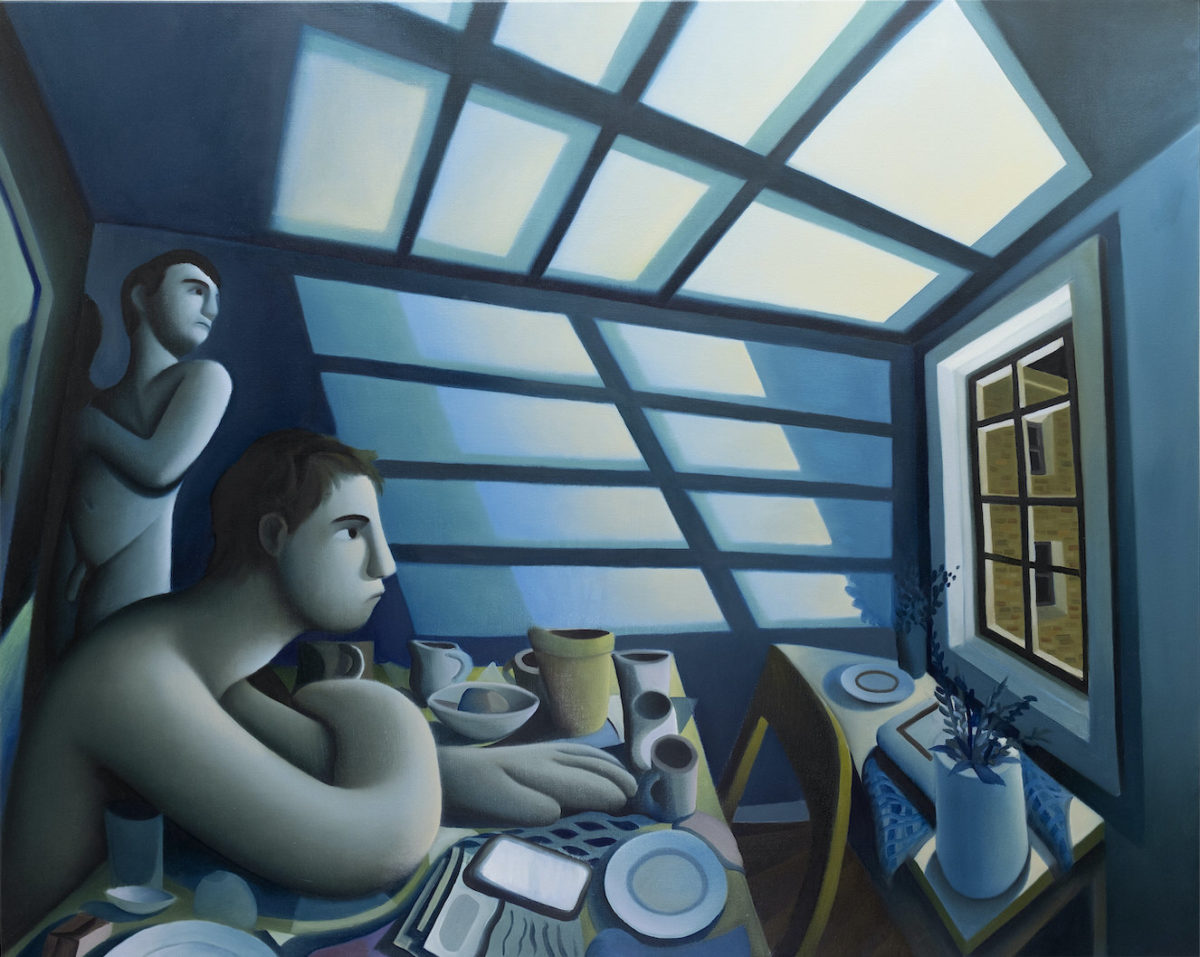
Loneliness is never far from Justin Liam O’Brien‘s paintings. In Bread on a Seder Plate, a new work which is currently showing at Richard Heller Gallery in Los Angeles, five lively figures are crowded around a brightly lit table, apparently deep in dinner party conversation, while two more sleep on the sofa behind them. But it is the eighth figure who really catches the viewer’s attention. Standing alone, he looks off canvas and appears to blend with his surroundings, his clothes and even his skin are tinged with the soft blue grey of the wall behind him. He is a figure that many people will relate to; most have felt this sense of sinking loneliness at some social event or other, hoping that the room might just swallow them up.
The painting also jars with this year, which has forced everyone to think differently about social and physical interaction. It is a stark reminder of the lively warmth that has been missing in 2020, and contrasts with the blue swathed room in I’m afraid of How This Ends, in which an illuminated window frame sheds a prison-like patch of gridded light on the walls and ceiling. Here, loneliness strikes again, though in a more of-the-moment way, as two figures find themselves alone except for one another, with, the painting suggests, little means of escape.
O’Brien’s figures have a distinctive bubbliness to their forms, with rounded faces and smoothed out skin, which he attributes to his previous work with 3D modelling software. I spoke with the artist about quarantine, violence, and a particularly “neurotic type of loneliness”.
- I'm Afraid of How This Ends, 2020
The bodies in your works are often incredibly close together, and seem to contrast massively with our socially distanced times. How has this year impacted your work?
Towards the beginning, around March or April, I started to seriously worry about how I would make work about closeness when we were all sequestered in our rooms. My paintings are frequently about how being close with people can be a mixed bag, both wonderful and terrible. Quarantine momentarily upended my ability to make that type of work. At some point I realized I would just have to make it up on my own without any impetus or inspiration from regular life, almost in spite of the situation. What could I want more right now than to be in a packed room? Or with a few people close together and touching each other? I think quarantine presents a compelling reason to make a painting of a room full of people, or of a few people in an intimate setting. Maybe we need to see people together now more than ever.
“My paintings are frequently about how being close with people can be a mixed bag, both wonderful and terrible”

It feels like there is always a tussle between intimacy and tension in your works, which veer between tenderness and violence. How do you see this balance playing out?
It’s a tricky balance. I try to present the situation as it occurs in real life. Sometimes things are fine on the surface but there’s something underneath. Maybe you’re being swept off your feet or it feels like everything is falling apart. Maybe you’re in love with someone but you want to kill them right now. Or worse, maybe you’re bored! I’ve been trying to make pictures about this for some time now. I try to show these diametrically opposed feelings just at the point of imbalance. I think the work is most successful when it feels like something is about to explode. In my current show at Richard Heller Gallery, I thought it would be interesting to paint the moment right after the explosion; to show some outright violence. That’s something new for me.

You previously worked in 3D modelling, how has this influenced the way you paint?
Lately I’ve been thinking of working in 3D modelling as a kind of second closet I needed to come out of. I was in school for 3D animation because I thought I wanted to make video games when I was in my early 20s. This is no longer the case, although I can’t deny that when I started painting more seriously I was trying to replicate the look of 3D models. I wanted the work to look computer generated.
I feel like the past few years I have allowed myself to paint more naturally, more honestly. Now I’m starting to think about healthy ways I can include 3D art into my practice. Using it as a tool for developing an idea or sketching rather than directly trying to replicate the look of a digital render.
- Learn to Swim, 2020
Can you tell me about the role of loneliness in your work?
It’s a major question I’m trying to understand. I recently realised that I’m thinking about loneliness more as a kind of pathological condition than something that’s brought about by actually being alone. I’m interested in a type of loneliness that is more like a defense mechanism or a neurosis. Almost like your subconscious is trying to get out ahead of the disaster of being abandoned by someone or rejected by a number of people. I suppose it’s a neurotic type of loneliness.

“I’m thinking about loneliness more as a kind of pathological condition than something that’s brought about by actually being alone”
Do you see yourself in any of your paintings? Are the figures taken from life and inspired by people you know or do you tend to create from your imagination?
I feel like I get in trouble with this because I’m so inconsistent! For every five paintings, one will be (sort of) taken from life. I end up painting physical spaces more directly than I do people. Mostly, I’m inventing the figures and situations. This will almost certainly change going forward. Recently I’ve been really enjoying working directly from life, or at least having something to reference in front of me as I paint or sketch. Sometimes it gives you so much more than your imagination can.
I suppose that inventing many of the figures defaults them to being self-portraiture in a way. I painted a huge crowd for my last show and, in a studio visit with a friend, had to defend that the figures were not unkind representations of people we know. I’m not that malicious! Although sometimes they do end up looking like someone. I thought one of the people in that crowd painting looked like Lady Gaga. My friend disagreed.







